In the Pink
Philadelphia fleabane is a native plant that lends a splash of color to roadsides this time of year.
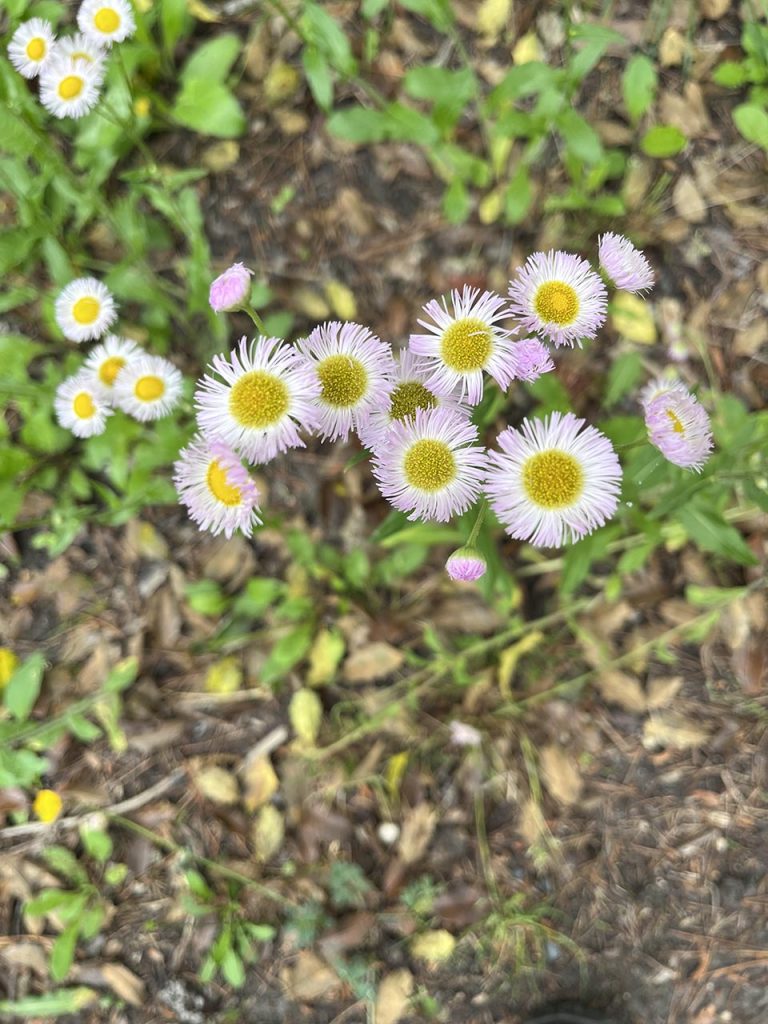
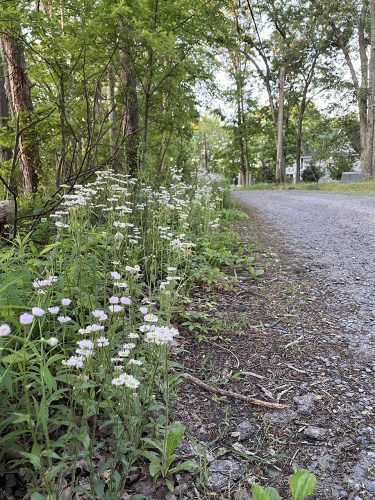
While walking the roadside at Laurel Lake we were greeted by the blooms of mountain laurel that commanded observation, but we also noticed that a less showy tiny aster was blooming. Some would think it to be a daisy but its thin petal-like ray flowers are much finer than those of a daisy or our fall asters. With numerous common names including “fleabane,” its scientific name is Erigeron philadelphicus. Multiple flower heads spring from each stem. Blooming in May and sporadically March to August, fleabane is in the Asteraceae (aster family). Other asters bloom in the fall.
The flower head is a half-inch to an inch across. Its 150 to 400 rays are pink to white to pale purple in color with a central yellow disk. Sporting basal leaves, it grows 11 to 35 inches tall and prefers full sun, but it tolerates shade and favors moist to wet conditions. It frequently grows on human-disturbed sites and is quite adaptable, showing up in wet meadows, grassy openings, floodplains, lowland woods, thickets, fields, streambanks, pastures, wet roadsides, and seepage. The flowers close at night (USDA/NRCS).
Fleabane is biennial, meaning it blooms every other year. It is also a short-lived perennial.
It has many common names and historically many uses. The common names include Philadelphia fleabane, common fleabane, fleabane daisy, daisy fleabane, and skervish. The genus name, Erigeron, comes from the Greek eri, “early,” and geron, “old man;” the hoary down on the stems and leaves is thought to be reminiscent of an old man’s beard.
Fleabane is a native plant that grows in all the lower 48 states except Utah and Arizona. It is also found in all the provinces of Canada with the exception of Nunavut. Common and widespread in North America, it also occurs as an exotic in Eurasia. Its status on the scale of occurrence is “globally secure” in both Canada and the United States. However it has a status of “imperiled” in Nova Scotia, Yukon, and Wyoming, and “critically imperiled” in Colorado (NatureServe).
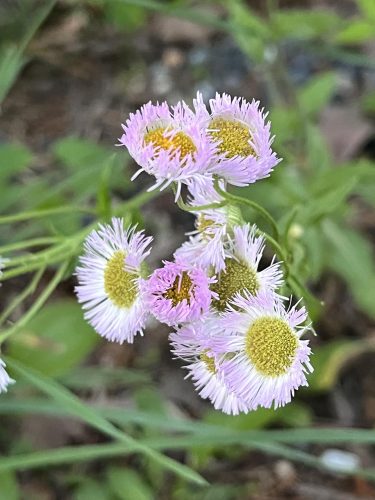 The plant is often viewed as a pest by the agricultural community. At 120,000 seeds per plant you can see why. For pollinators, butterflies, moths, and deer it is a treat, and for those of us walking the roadsides it provides a splash of color that may otherwise be absent. I can’t say I would encourage growing it in the garden unless you have a large natural area; at times it has been very prolific in mine among the other native plant species.
The plant is often viewed as a pest by the agricultural community. At 120,000 seeds per plant you can see why. For pollinators, butterflies, moths, and deer it is a treat, and for those of us walking the roadsides it provides a splash of color that may otherwise be absent. I can’t say I would encourage growing it in the garden unless you have a large natural area; at times it has been very prolific in mine among the other native plant species.
I tolerate the plant until it gets what I consider to be too plentiful. Fortunately, it is easy to pull if it spreads more than you desire. In my opinion it is cute, but even cute can cross a line and displace desirable vegetation. Depending on your preferences it may be best suited for naturalized areas and prairie.
“Desirable” is a subjective term but allow me a soapbox moment. Much of what Americans try to eradicate with unhealthy herbicides are “native plants,” which most folks call “weeds”—plants that are often beneficial for local animal populations and especially birds. And what folks grow deliberately are exotic plants with no connection to our local food chain, so they won’t ever see a chewed-up leaf because no self-respecting critter would eat it. One of my like-minded friends refers to exotics as “plastic plants.”
My advice: If you’re going to kill something, let it be an exotic invasive like English ivy, knotweed, Japanese honeysuckle, autumn olive, kudzu, tree of heaven, or a host of other truly awful plants—while you save and plant native species. Do I have invasives in my yard? Yes, most people do. Even if you work hard to eliminate exotics species they invade our landscape from the plantings of others. We should be purposefully planting natives and getting rid of invasives. From a biological standpoint fleabane is far superior to lawn turf.
Okay, I’ll step down from the podium and return to my focus on fleabane. The “bane” aspect of its name has dark connotations, deriving from Anglo-Saxon “bana” for “destroyer.” Plants having bane in their names are usually characterized by toxicity that discourages unwanted animals. In the instance of fleabane, as its common name suggests, it was used to ward off flea infestations.
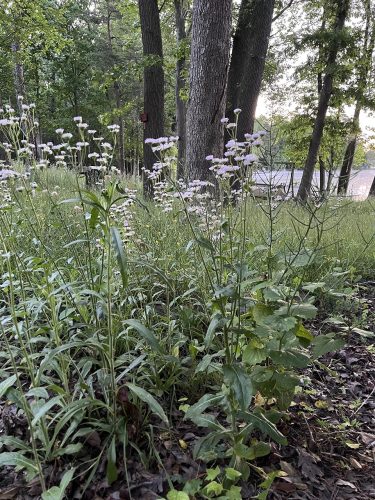
Since historically fleabane was associated with repelling insects, people made use of its aromatic qualities to discourage them. They hung it from the eaves of their homes and stuffed pillows and mattresses with it. It was also employed as a fumigant, where burning it released chemical properties to discourage bugs. Sadly, there is little evidence of its effectiveness in this regard (Brooklyn Botanic Garden).
Birds often incorporate plants with pesticide-type qualities to repel parasites. Scientists studying fleabane found it “substantially reduces the emergence of feeding instars of mites, while garlic mustard had little effect on them,” (Clark/Mason). Ectoparasites, like fleas and ticks, which live outside a host’s body, can affect the outcome of nesting birds’ success.
Native Americans had many medicinal uses for Philadelphia fleabane. The Blackfoot used it as an antidiarrheal while Cherokees employed it for menstruation maladies, headaches, hemorrhages (when people spit blood), and epilepsy. Root infusions and chewed roots were employed as a cold remedy and cough suppressant. Plants were boiled and mixed with tallow for skin lesions. Kidney disorders, dimness of sight, gout, are all associated with Cherokee medical uses of this plant. Iroquois, Meskwaki, Ojibwa, Okanagan-Colville, and Houma tribes valued it for many of the same problems. Some tribes prepared it for lung ailments, as snuff to clear sinuses, and for the itch of poison ivy, and Ojibwa smoked florets to attract deer.
It would be wise to mention that the hoary down on the stems and leaves of some fleabanes (170 known species in N. America) can cause an itchy reaction. It is edible but boiling is necessary to remove small hairs from stems and leaves. Those who eat it say it tastes similar to spinach.
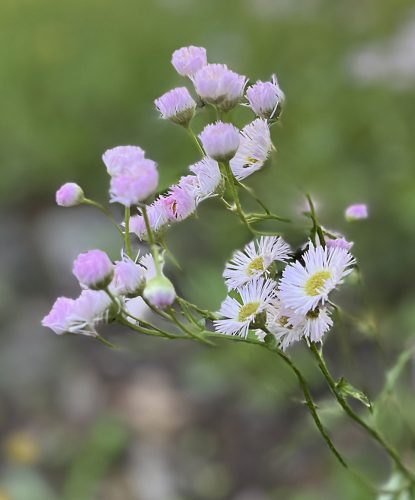 This weedy perennial native herb has many virtues and few liabilities. Just like the Philadelphians who purchased postage stamp-sized lots in Laurel Lake from advertisements printed in Philadelphia newspapers, the Philadelphia fleabane also found a home on the shores of the impounded Buckshutem Creek, and we enjoyed its pink hues on our walk. n
This weedy perennial native herb has many virtues and few liabilities. Just like the Philadelphians who purchased postage stamp-sized lots in Laurel Lake from advertisements printed in Philadelphia newspapers, the Philadelphia fleabane also found a home on the shores of the impounded Buckshutem Creek, and we enjoyed its pink hues on our walk. n
Sources
- United States Department of Agriculture, Natural Resources Conservation Service, Plant Guide, Philadelphia Fleabane
- University of Florida, Institute of Food and Agricultural Sciences, What Is That Lawn Ornament? A Daisy That Keeps Away Fleas? Daisy Fleabane!, by Forest Hecker.
- Effect of Biologically Active Plants used as nest material and derived benefit to starling nestlings, Larry Clark and J. Russell Mason.
- NatureServe Explorer, www.explorer.natureserve.org.
- Native American Ethnobotany, Daniel E. Moerman.
- Lady Bird Johnson Wildflower Center, Erigeron philadelphicus, www.wildflower.org
- Brooklyn Botanic Garden, “Weed of the Month: Fleabane,” by Saara Nafici.









